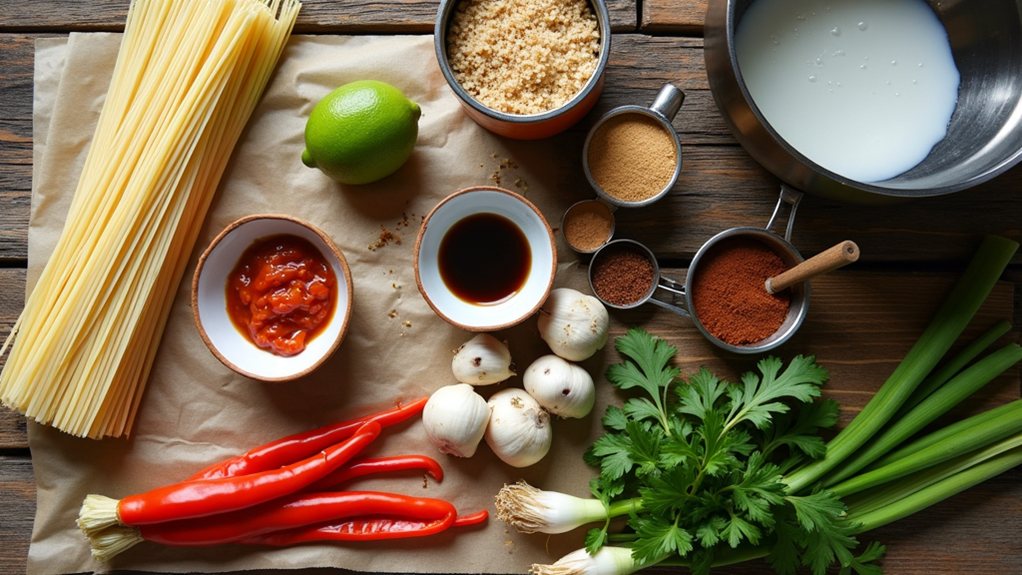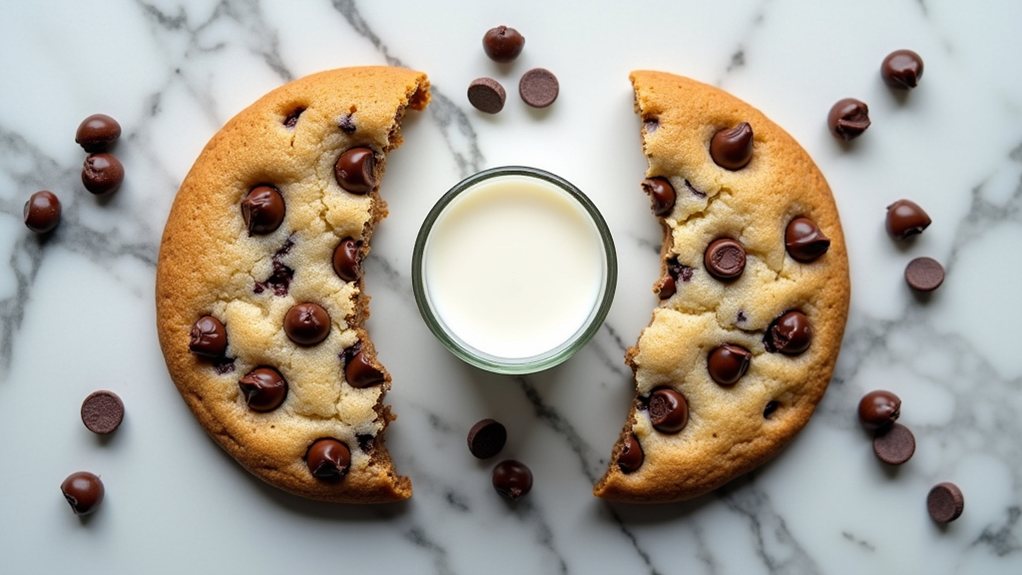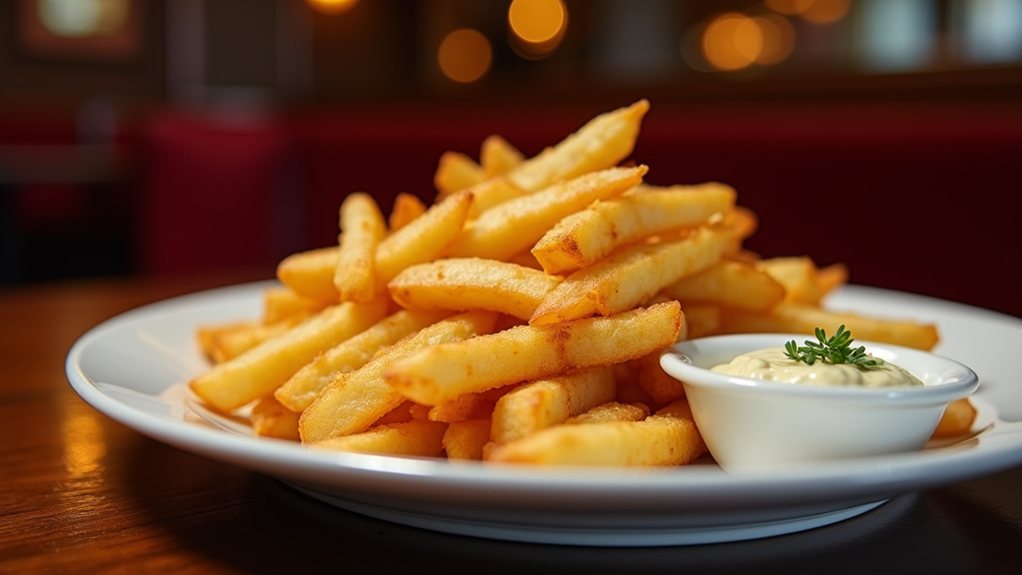Making coconut curry noodles at home offers better flavor than takeout versions. The secret lies in balancing aromatic spices with creamy coconut milk and perfectly cooked rice noodles. Home cooks can control the heat level, vegetable freshness, and protein options to suit their preferences. When finished with bright garnishes like cilantro and lime, these noodles transform from a simple dish into something restaurant-worthy. But what specific techniques enhance homemade curry noodles from good to extraordinary?
Luscious Noodles Assembly

These creamy coconut curry noodles combine the perfect balance of textures and flavors for a satisfying meal that's both comforting and exciting. Rice noodles serve as a delicate base, soaking up the rich coconut curry sauce while maintaining their distinctive texture. The beauty of this dish lies in its harmonious layering – tender noodles, velvety sauce, crisp vegetables, and protein of your choice all working together.
The secret to truly luscious noodles lies in the careful assembly and timing. By cooking the noodles just until al dente and creating a deeply flavored curry sauce with the right balance of spices, coconut milk, and aromatics, you'll achieve a bowl that's both Instagram-worthy and incredibly satisfying. The combination of creamy, spicy, sour, and fresh elements creates a bowl that hits all the right notes. Similar to traditional Biang Biang noodles, the hot oil technique helps bloom the spices, releasing more flavor compounds than water-based cooking alone. Much like preparing crispy air fryer dishes, the key to perfect texture is proper timing and temperature control.
Ingredients
- 8 oz rice noodles (or brown rice noodles)
- 2 tbsp vegetable oil
- 3 cloves garlic, minced
- 1 tbsp ginger, grated
- 3 tbsp red curry paste
- 1 can (14 oz) full-fat coconut milk
- 1 cup vegetable or chicken stock
- 2 tsp brown sugar
- 1 tbsp soy sauce
- 1 red bell pepper, sliced
- 8 oz mushrooms, sliced
- 1 lb protein (chicken, shrimp, or firm tofu)
- 2 green onions, sliced
- 1/4 cup fresh cilantro, chopped
- 1 lime, cut into wedges
- 1/4 cup crispy fried onions or crushed peanuts
- Red chili flakes (optional, to taste)
Cook the rice noodles according to package instructions until just al dente, then drain and rinse with cold water to stop the cooking process.
Meanwhile, heat oil in a large pan over medium heat and sauté garlic and ginger until fragrant. Add curry paste and stir for 30 seconds until aromatic, then pour in coconut milk and stock, bringing to a gentle simmer.
Add brown sugar and soy sauce, then incorporate your protein and cook until done. Add the bell pepper and mushrooms, cooking for 2-3 minutes until slightly softened but still maintaining texture.
Toss the cooked noodles directly in the sauce, ensuring they're well-coated, then remove from heat.
For the best results, serve immediately while the noodles are still hot and have the perfect texture. If preparing components ahead of time, keep the noodles and sauce separate until just before serving to prevent the noodles from absorbing too much liquid and becoming soggy.
For an extra touch of indulgence, a dollop of sour cream or yogurt can be added on top to improve creaminess and balance spice. Adjust the amount of curry paste and chili flakes according to your spice preference – you can always add more heat with chili sauce on the side for those who enjoy an extra kick.
Spice Balancing Secrets
Creating an exquisite spice balance sits at the heart of truly memorable coconut curry noodles. The key lies in layering flavors, starting with foundation spices like cumin, coriander, and turmeric before building complexity. Toasting whole spices first will release their essential oils and enhance their aromatic qualities throughout your curry base.
For perfect heat control, add chili powder gradually, tasting as you go. Too spicy? Incorporate a tablespoon of coconut milk or a squeeze of lime juice to temper the heat. The dairy proteins in coconut milk bind to spice compounds, reducing their impact.
Regional influences can transform your dish entirely—add red curry paste for Thai flair or garam masala for Indian depth. Try combining a teaspoon of fish sauce with fresh herbs for Southeast Asian notes. Using a digital pressure cooker can help you achieve restaurant-quality curry noodles in thirty minutes or less while maintaining perfect flavor integration.
Keep track of successful combinations in a kitchen notebook. Soon you'll develop signature blends that enhance your noodles far beyond standard takeout offerings.
Garnish for Maximum Impact
The perfect garnish transforms ordinary coconut curry noodles into an Instagram-worthy masterpiece that delights all senses.
When selecting garnishes, focus on creating color contrast against the vibrant yellow-orange sauce, enhancing both presentation and flavor.
Fresh cilantro leaves scattered across the top add a bright green pop and herbaceous aroma. Toasted sesame seeds or crushed peanuts provide crucial textural contrast with their satisfying crunch. A lime wedge on the side isn't just decorative—it allows diners to adjust acidity to taste.
For a regional twist, consider adding a dollop of pimento cheese that melts beautifully into the warm noodles.
For special occasions, consider adding a few paper-thin red chili slices or delicate microgreens. Remember to use these finishing touches sparingly and purposefully to maintain the dish's integrity. These finishing touches aren't merely decorative; they balance flavors and create visual interest that heightens the dish.





